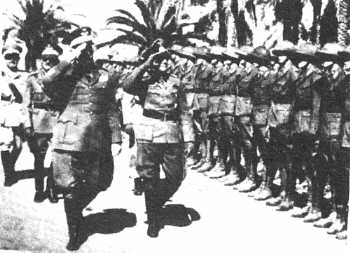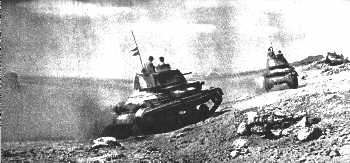As we gear up for the opening moves of DAK2 I thought this background reading was worth noting on Compass. It is a compilation of articles and data from the Italian view point, with a lot of details on forces strengths.
The Italian advance had left a bitter taste in Churchill’s mouth, the British Commander in Chief in Egypt, Gen. Wavell, quickly received a massive supply of modern materials, including 152 new tanks (50 of which were the heavy infantry tanks Matilda II), anti-tank and Bofors anti-aircraft guns, machine-guns and ammunition. Wavell immediately planned a counter-offensive but, due to the October 1940 Italian invasion of Greece, he had to divert to the Balkan front-line a good portion of his air force.
The British revenge in North Africa had, therefore, to be postponed.
During the next two months the British Corps underwent a hard drill program, including long lasting day and night displacements, back and forth in the desert, focused to a fast 5-days raid (the “Operation Compass”).
At the beginning of December 1940, the British had gained the supremacy in terms of armoured warfare as the 7th Armoured Division deployed 495 vehicles :
- 195 light tanks (Vickers Mk VI)
- 114 medium tanks (Vickers medium and Cruiser Mk I)
- 64 heavy cruiser tanks (A 10, A 13, A15 Crusader)
- 48 heavy infantry tanks (Matilda II)
- 74 armoured cars (Marmon Herrington, Daimler, Humber, and Morris)
The Italian Armour Brigade in the Sidi-el-Barrani area consisted of 275 vehicles:
- 220 light tanks (L3)
- 55 medium tanks (M11/39)
Elsewhere in Libya there were, still under fitting-out, the first new M13/40 medium tanks.
During the night between December 8 and 9, 1940 the British surrounded Sidi el-Barrani with their tanks. At 7:00 am the British artillery began a heavy bombardment. Gen. Maletti, one of the base Commanders, moved then his mixed tank batallion (two tank companies : one of L3, one of M11/39) to withstand the British heavy tanks.
The result of the combat was the complete destruction of the Italian tank battalion as the 37 mm shells could just scratch, without piercing, the thick armour of the British Matildas. Gen. Maletti was killed in action by a British machine-gunner. In the afternoon there was another tank combat around the Alam el-Tummar stronghold : the all-L3 Italian armoured unit was completely swept out.
On December 10, 1940 Sidi el-Barrani was in the hands of Gen. O’Connor while the remnants of the Italian 10th Army Corps retreated to Sollum and Sidi Omar.
As the offensive was a such a great success, Gen.Wavell, urged by Gen. O’Connor, agreed to continue the advance.By the end of December 1940, in spite of the Italian Air Force bombing raids which created serious problems to the British tanks, the O’Connor’s 4th Armoured Brigade and 7th Armoured Division took Sollum, Sidi Omar and Ridotta Capuzzo, the Italian strong points on the Libyan border, but could not prevent Gen. Bergonzoli and his troops from withdrawing into the Bardia fortress, few miles eastwards.
The attack to Bardia was carried out by the 6th Australian infantry division, supported by the 7th Royal Tank Regiment (7th RTR) and, on a second line, by the 7th Armoured Division.
The action started at 7:30am of January 3, 1941, when the Australian troopers cut the barbed wire entanglements with their bangalore and let 22 Matilda heavy tanks to enter within the defensive perimeter. The 12 Italian M13/40 medium tanks, and few L3 light tanks, supported by anti-tank weaponry, moved against the British tanks but the Matildas‘ armour was invulnerable to the 47mm shells. Once again the Italian tankers had to pay a terrible tribute of blood and tears to the poor quality of their armament.
On January 5, 1941 the Bardia fortress was taken by the British who made a terrific booty : 32.000 prisoners, about 450 guns, 700 lorries, and 127 tanks.
On the subsequent day the British troops were besieging the Italian outposts near Tobruk. The Italian armoured warfare in the area comprised :
- Tobruk : about 25 L3-type light tanks, 11 M11/39 medium tanks (all under repair and therefore not available for combat), and about 60 M13/40 tanks (scraped together here and there)
- Ain el-Gazala airport (25 miles west of Tobruk) : 5 M11/39 medium tanks
- El-Mechili (50 miles southwest of Tobruk) : the armoured brigade with 61 M13/40 medium tanks and 24 L3-type light tanks
The point of this detail is that – there was a mismatch of weaponry and bodies! In the next days Tobruk was captured by the 22nd of Jan.
O’Connor, encouraged by the campaign progress, moved forwards his divisions aiming to Benghazi. The British forces followed two routes : one along the coast towards Derna, Cirene, Barce), the other straight through the desert. This latter led the British units (two armoured brigades with not less than four tank and one armoured car regiments) to a close encounter with the Italian armoured brigade in El-Mechili. Thus the Battle of Beda Fomm was about to commence.
|
The last tank battle of the campaign was that fought in Beda Fomm between February 5 and 7, 1941. In this location, south of Benghazi, the already mentioned two British armoured brigades clashed with a second Italian armoured brigade (about 100 M13 medium tanks).
At the end of three days of furious combats, the British heavy tanks disposed of all the Italian tanks.
Apart from the poor quality of the armament (armour and gun) which had made the Matildas and the Valentines practically invulnerable for the M13s, the Italian armored units were disrupted because they failed to adopt the en-masse deployment strategy, burning hundreds of crews in short range combats conducted by small groups of tanks destined to one fate only : destruction !
Thus we see the third leg of woe for forces fighting here early in WWII. Clinging to tactics used in WWI, caused massive losses in terrain that favoured the mobile, the hull down and the first to shoot!
On February 12, 1941 the winning march of the British armoured corps stopped in El-Agheila. It had been a remarkable cavalcade which had kicked-off, in less than four months, the Italians from the Cyrenaica … but the Fate was planning a nasty trick on the British hopes.

On the same day, in Tripoli, Rommel the German general was starting to warm the engines of the Afrika Korps panzers.


One thought on “Dak II [Op Compass] and tanks”
Comments are closed.